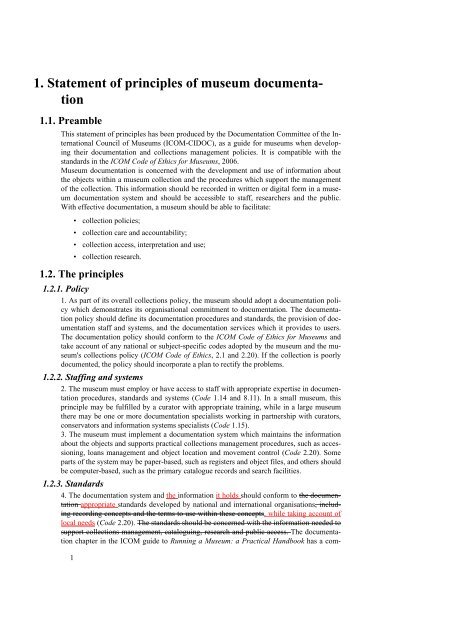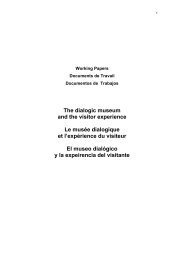1. Statement of principles of museum documenta - The International ...
1. Statement of principles of museum documenta - The International ...
1. Statement of principles of museum documenta - The International ...
You also want an ePaper? Increase the reach of your titles
YUMPU automatically turns print PDFs into web optimized ePapers that Google loves.
<strong>1.</strong> <strong>Statement</strong> <strong>of</strong> <strong>principles</strong> <strong>of</strong> <strong>museum</strong> <strong>documenta</strong>tion<br />
<strong>1.</strong><strong>1.</strong> Preamble<br />
This statement <strong>of</strong> <strong>principles</strong> has been produced by the Documentation Committee <strong>of</strong> the <strong>International</strong><br />
Council <strong>of</strong> Museums (ICOM-CIDOC), as a guide for <strong>museum</strong>s when developing<br />
their <strong>documenta</strong>tion and collections management policies. It is compatible with the<br />
standards in the ICOM Code <strong>of</strong> Ethics for Museums, 2006.<br />
Museum <strong>documenta</strong>tion is concerned with the development and use <strong>of</strong> information about<br />
the objects within a <strong>museum</strong> collection and the procedures which support the management<br />
<strong>of</strong> the collection. This information should be recorded in written or digital form in a <strong>museum</strong><br />
<strong>documenta</strong>tion system and should be accessible to staff, researchers and the public.<br />
With effective <strong>documenta</strong>tion, a <strong>museum</strong> should be able to facilitate:<br />
• collection policies;<br />
• collection care and accountability;<br />
• collection access, interpretation and use;<br />
• collection research.<br />
<strong>1.</strong>2. <strong>The</strong> <strong>principles</strong><br />
<strong>1.</strong>2.<strong>1.</strong> Policy<br />
<strong>1.</strong> As part <strong>of</strong> its overall collections policy, the <strong>museum</strong> should adopt a <strong>documenta</strong>tion policy<br />
which demonstrates its organisational commitment to <strong>documenta</strong>tion. <strong>The</strong> <strong>documenta</strong>tion<br />
policy should define its <strong>documenta</strong>tion procedures and standards, the provision <strong>of</strong> <strong>documenta</strong>tion<br />
staff and systems, and the <strong>documenta</strong>tion services which it provides to users.<br />
<strong>The</strong> <strong>documenta</strong>tion policy should conform to the ICOM Code <strong>of</strong> Ethics for Museums and<br />
take account <strong>of</strong> any national or subject-specific codes adopted by the <strong>museum</strong> and the <strong>museum</strong>'s<br />
collections policy (ICOM Code <strong>of</strong> Ethics, 2.1 and 2.20). If the collection is poorly<br />
documented, the policy should incorporate a plan to rectify the problems.<br />
<strong>1.</strong>2.2. Staffing and systems<br />
2. <strong>The</strong> <strong>museum</strong> must employ or have access to staff with appropriate expertise in <strong>documenta</strong>tion<br />
procedures, standards and systems (Code <strong>1.</strong>14 and 8.11). In a small <strong>museum</strong>, this<br />
principle may be fulfilled by a curator with appropriate training, while in a large <strong>museum</strong><br />
there may be one or more <strong>documenta</strong>tion specialists working in partnership with curators,<br />
conservators and information systems specialists (Code <strong>1.</strong>15).<br />
3. <strong>The</strong> <strong>museum</strong> must implement a <strong>documenta</strong>tion system which maintains the information<br />
about the objects and supports practical collections management procedures, such as accessioning,<br />
loans management and object location and movement control (Code 2.20). Some<br />
parts <strong>of</strong> the system may be paper-based, such as registers and object files, and others should<br />
be computer-based, such as the primary catalogue records and search facilities.<br />
<strong>1.</strong>2.3. Standards<br />
4. <strong>The</strong> <strong>documenta</strong>tion system and the information it holds should conform to the <strong>documenta</strong>tion<br />
appropriate standards developed by national and international organisations, including<br />
recording concepts and the terms to use within these concepts, while taking account <strong>of</strong><br />
local needs (Code 2.20). <strong>The</strong> standards should be concerned with the information needed to<br />
support collections management, cataloguing, research and public access. <strong>The</strong> <strong>documenta</strong>tion<br />
chapter in the ICOM guide to Running a Museum: a Practical Handbook has a com-<br />
1
2<br />
parison <strong>of</strong> a number <strong>of</strong> these standards, including the CIDOC Conceptual Reference Model<br />
(CRM), the CIDOC Guidelines, the AFRICOM Handbook and SPECTRUM. <strong>The</strong> LIDO<br />
standard should be taken into account when planning the contribution <strong>of</strong> data to, and interchange<br />
with, other systems.<br />
<strong>1.</strong>2.4. Information access and user needs<br />
5. <strong>The</strong> <strong>museum</strong> should evaluate the needs <strong>of</strong> its users and where appropriate provide services<br />
tailored to different categories <strong>of</strong> user, such as researchers, teachers and students,<br />
learners and the general public. <strong>The</strong>se services should include a research area where visitors<br />
can consult paper records and files, together with manual or online search facilities giving<br />
access to catalogue records, images, contextual information and other resources. <strong>The</strong><br />
<strong>museum</strong> should consider widening access by providing information about its collections to<br />
central metadata registries such as Europeana (Code 2.20, 3.2 and 8.4).<br />
6. <strong>The</strong> search facilities should enable staff and users to find relevant information about the<br />
collection and individual objects, by searching for criteria such as object name, title, object<br />
type or classification, material, collection place, producer, production date or period and<br />
object number (Code 2.20 and 3.2).<br />
7. <strong>The</strong> system must enable the <strong>museum</strong> to restrict access to confidential information and<br />
details affected by copyright constraints, while respecting Freedom <strong>of</strong> Information legislation.<br />
<strong>The</strong> restricted information may include details such as identifying marks or defects,<br />
valuations, storage locations and the exact find spots <strong>of</strong> natural history or archaeology objects<br />
(Code 2.20, 2.22, 3.2 and 8.6).<br />
<strong>1.</strong>2.5. Information and procedures<br />
8. <strong>The</strong> <strong>documenta</strong>tion must include evidence <strong>of</strong> the basis on which each object came into<br />
the <strong>museum</strong>. In the case <strong>of</strong> an object that has been permanently acquired, the <strong>documenta</strong>tion<br />
must define the acquisition method, date, source and any conditions. <strong>The</strong> <strong>museum</strong><br />
must be satisfied that the source has valid title to the object and confirm the provenance <strong>of</strong><br />
the object (Code 2.2-2.4). In the case <strong>of</strong> an object that has been temporarily brought into the<br />
<strong>museum</strong>, the <strong>documenta</strong>tion must establish why it was accepted, the date, source, the anticipated<br />
return date and whether it has been returned.<br />
9. <strong>The</strong> <strong>museum</strong> must record information about the provenance <strong>of</strong> an acquired object from<br />
its discovery or creation to the present, including - where appropriate - its production, collection,<br />
ownership and contextual details about its use (Code 2.3). <strong>The</strong> <strong>documenta</strong>tion<br />
should cite the source <strong>of</strong> this information. Source material held by the <strong>museum</strong> (including<br />
<strong>documenta</strong>ry photographs) should be considered to be an integral part <strong>of</strong> the <strong>documenta</strong>tion<br />
system. Such materials should be managed to archival standards. Details obtained from an<br />
external source, such as the previous owner or a researcher, should be verified by the <strong>museum</strong>.<br />
It is particularly important to obtain information about an object's use and history from<br />
the donor or vendor as a routine part <strong>of</strong> the acquisition process.<br />
10. Each object must be assigned a unique number or identifier, which should be recorded<br />
within the <strong>documenta</strong>tion system. <strong>The</strong> object should be marked or labelled with the number.<br />
<strong>The</strong> location <strong>of</strong> the object should be recorded within the <strong>documenta</strong>tion system, irrespective<br />
<strong>of</strong> whether the object is in its normal location or has been moved to another location,<br />
such as a conservation laboratory.<br />
1<strong>1.</strong> In the event <strong>of</strong> the loss or theft <strong>of</strong> an object, the <strong>museum</strong> should be able to provide law<br />
enforcement agencies with information and images that can be used to help with its recovery,<br />
such as its unique number, production date or period, maker, materials, measurements,<br />
physical condition and distinguishing features. <strong>The</strong> Object ID standard provides guidelines<br />
on the concepts that are appropriate for this purpose.<br />
2
3<br />
12. <strong>The</strong> <strong>documenta</strong>tion must include information about any intellectual property rights concerning<br />
the object. In order to respect these rights, the <strong>museum</strong> should document the owners<br />
<strong>of</strong> any associated intellectual property rights, and monitor any transfer <strong>of</strong> these rights.<br />
13. <strong>The</strong> system should incorporate the results <strong>of</strong> research and other published material<br />
about the object or references to such information, such as exhibition catalogue entries. If<br />
the object is cited in published material, the author should refer to the unique number <strong>of</strong> the<br />
object.<br />
14. If the existing collection is inadequately documented, the <strong>museum</strong> should implement a<br />
programme to upgrade the <strong>documenta</strong>tion by an agreed deadline. <strong>The</strong> sources for this information<br />
may include a physical stocktaking and a review <strong>of</strong> any original registers and files.<br />
<strong>The</strong> first priority should be to establish a baseline inventory <strong>of</strong> the collection, with primary<br />
information about each object, such as unique number, location, object name and condition.<br />
If objects are found without a number and the old number cannot be traced in the original<br />
<strong>documenta</strong>tion, they may need to be assigned a new number during this process.<br />
15. In addition to details about individual objects, the <strong>museum</strong> should develop information<br />
about themes and subjects <strong>of</strong> relevance to the collection. It should develop details about the<br />
people, organisations and cultures associated with the collection, such as donors, collectors,<br />
producers, and previous owners and users. If appropriate, it should also develop information<br />
about archaeological and natural history sites and their surrounding environments and<br />
archaeological processes (Code 3.3).<br />
16. <strong>The</strong> system should provide facilities which enable the collection information to be incorporated<br />
in resources such as education and interpretation material and online exhibitions<br />
and learning resources.<br />
17. <strong>The</strong> <strong>documenta</strong>tion system should provide procedural support for collections management,<br />
such as the steps to be followed and decisions to be taken when lending an object to<br />
another institution.<br />
18. <strong>The</strong> system should incorporate information about the outcome <strong>of</strong> each significant collections<br />
management activity affecting an object, such as conservation (Code 2.24), photography,<br />
loans-out and its use in exhibitions and displays.<br />
19. If an object is deaccessioned, its <strong>documenta</strong>tion should be retained by the <strong>museum</strong>. If<br />
the object is transferred to another <strong>museum</strong>, a copy <strong>of</strong> the <strong>documenta</strong>tion should be passed<br />
to that <strong>museum</strong>. Details <strong>of</strong> the basis on which an object was deaccessioned and the formal<br />
approval <strong>of</strong> this action must be added to the <strong>documenta</strong>tion about the object (Code<br />
2.12-2.17).<br />
<strong>1.</strong>2.6. Security, sustainability and preservation<br />
20. <strong>The</strong> system must include provisions for the security, sustainability and the long-term<br />
preservation <strong>of</strong> information, such as storing registers in a fire-pro<strong>of</strong> safe, storing paper files<br />
in an environmentally controlled archive, backing-up and restricting access to digital information<br />
and ensuring that digital information is transferred from superseded systems and file<br />
formats into current systems (Code <strong>1.</strong>6 and 2.20-2.22).<br />
<strong>1.</strong>3. References and sources<br />
<strong>1.</strong> Further information about collections <strong>documenta</strong>tion is available from the CIDOC<br />
Web site (http://cidoc.icom.<strong>museum</strong>).<br />
2. <strong>International</strong> Council <strong>of</strong> Museums (1996). Handbook <strong>of</strong> standards. Documenting African<br />
collections. Paris: ICOM. ISBN 92-9012-029-0. [English-French edition.]<br />
(http://icom.<strong>museum</strong>/afridoc/)<br />
3. <strong>International</strong> Council <strong>of</strong> Museums (1997). Handbook <strong>of</strong> standards. Documenting African<br />
collections. Paris: ICOM. ISBN 92-9012-639-6. [Arabic edition, ICOM-Tunis.]<br />
3
4<br />
4<br />
4. <strong>International</strong> Council <strong>of</strong> Museums (2004). Running a <strong>museum</strong>: a practical handbook.<br />
Paris: ICOM. ISBN 92-9012-157-2. (Also in Arabic.)<br />
5. <strong>International</strong> Council <strong>of</strong> Museums (2006). ICOM Code <strong>of</strong> Ethics for Museums. Paris:<br />
ICOM. (http://icom.<strong>museum</strong>/ethics.html)<br />
6. <strong>International</strong> Council <strong>of</strong> Museums. <strong>International</strong> Committee for Documentation (CI-<br />
DOC) (1995). <strong>International</strong> Guidelines for Museum Object Information: <strong>The</strong> CI-<br />
DOC Information Categories. Edited by a joint project team <strong>of</strong> the CIDOC Data and<br />
Terminology and the CIDOC Data Model Working Groups. Editors: Alice Grant,<br />
Joséphine Nieuwenhuis, Toni Petersen. Paris: CIDOC. Printed version, ISBN<br />
92-9012-124-6. (http://www.cidoc.icom.org/guide/guide.htm)<br />
7. Collections Trust (2011). SPECTRUM: <strong>The</strong> UK Museum Documentation Standard.<br />
Fourth edition. Edited by Alex Dawson and Susanna Hillhouse. (http://www.collectionslink.org.uk/spectrum-standard)<br />
8. <strong>International</strong> Organization for Standardization (2006). Information and Documentation<br />
- a Reference Ontology for the Interchange <strong>of</strong> Cultural Heritage Information.<br />
ISO 21127:2006. Geneva: ISO. (http://www.iso.org/iso/en/CatalogueDetail-<br />
Page.CatalogueDetail?CSNUMBER=34424&scopelist=PROGRAMME) (<strong>The</strong> CI-<br />
DOC Conceptual reference Model, CRM, see http://cidoc.ics.forth.gr)<br />
9. Object ID (http://icom.<strong>museum</strong>/object-id)<br />
10. Coburn, E. & Light, R. & McKenna, G. & Stein, R. & Vitzthum, A. (2010) LIDO -<br />
Lightweight Information Describing Objects Version <strong>1.</strong>0. (http://www.lido-schema.org/schema/v<strong>1.</strong>0/lido-v<strong>1.</strong>0-specification.pdf)



